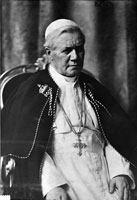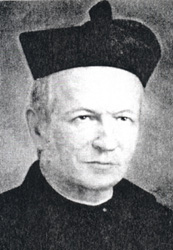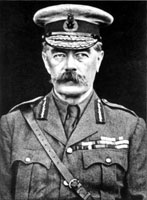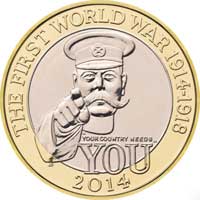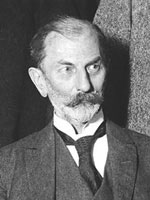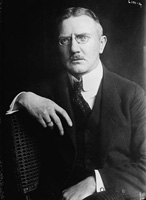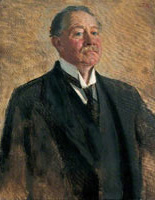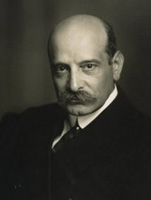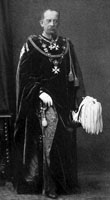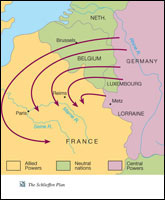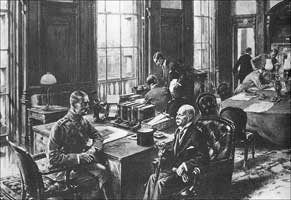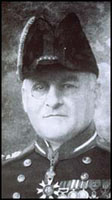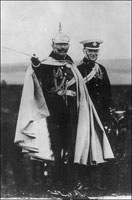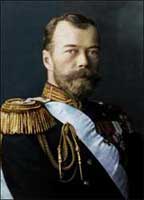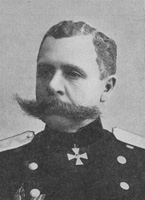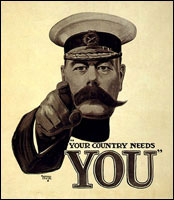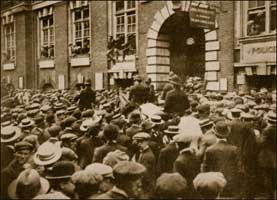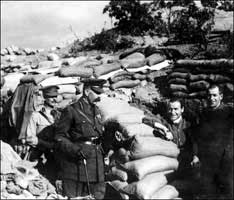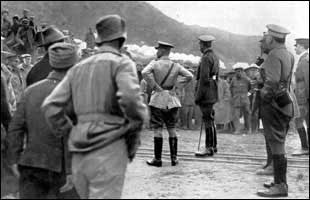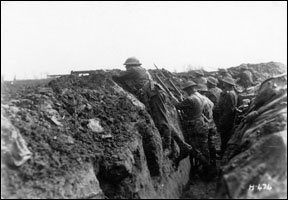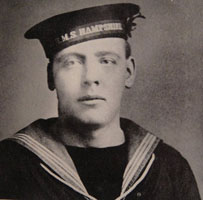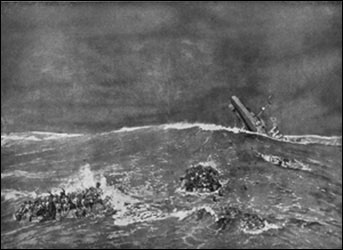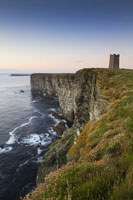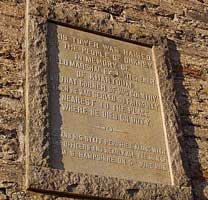World
War I raged from August 1914 to November 1918. Total casualties numbered over 50 million people!! |
The catalyst for World War I was the assassination of the Archduke and Duchess of Austria-Este, in Sarajevo, on June 28, 1914. They were the first 2 casualties in a war that would eventually consume over 50 million people either killed, wounded, victims of genocide, or the "Spanish Flu."
The war led to the Russian Revolution, the rise of Hitler, World War II, the Holohoax, the smokescreen state of "Israel," the Cold War, the Korean War, the Vietnam War etc., etc....In 1918, 26-year-old Walt Disney drove an ambulance in France.
|
The war was supposed to be a repeat of the Franco-Prussian War of 1870; with France capitulating quickly, and then Imperial Germany would send its vast armies eastward to defeat Orthodox Russia before the winter. That was the plan . . . but they reckoned without the Almighty:
Then the king of Israel replied, “Tell him, ‘Let not him who girds on his armor boast like him who takes it off’”
(I Kings 20:11).
Once the dogs of war are unleashed, nobody can predict the outcome. In order to reduce the fog of war, generals like to have their spies commanding the opposing side.
|
Ex Consul-General of the Sudan Kitchener was the perfect man for starting the war because he almost started a war between Britain and France in 1898. The Fashoda Incident in the Sudan, initiated by Francophobe Kitchener, was only defused when both sides compromised. The real aim of the British Empire in the bloody Sudanese War (1873–1898) was control of the French built Suez Canal.
War is the most expensive and destructive activity of fallen mankind. If you follow the money trail, and find out who is paying the salaries of the soldiers, it is easy to unmask the real sponsors of the conflict. A typical example of this was the American Revolution, which was financed by the silver mines of Mexico . . . and the Hudson's Bay Company!!
|
Money doesn't grow on trees–even in Germany, so gold stolen from the Boers of South Africa was used to finance the German military buildup.
|
Neither man expected that the conflict would last longer than 6 weeks on the Western Front. David Lloyd George was the only Welshman to ever serve as Prime Minister. They haven't forgotten what happened when Welsh Tudor King Henry VIII reigned!!
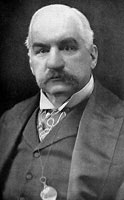 J. P. Morgan (1837–1913). |
|
The "Federal" Reserve System (a devil in every dollar) hijacked the U.S. financial system after its creation in 1913. All the wars that the "United States" fought since that time were financed by that sinister monopoly.
Britain was broke just a year after the war began, so Imperial Germany, with far less financial resources, was financed by J.P. Morgan via "neutral" Switzerland.
The proposed lighting conquest of France was called the Schlieffen Plan!!
The plan for this lighting conquest was called the Schlieffen Plan, named after Count Alfred Graf von Schlieffen (1833–1913). The Schlieffen Plan would employ an early version of Blitzkrieg–lightning warfare–to quickly overthrow France before Russia could fully mobilize.
|
Kaiser Wilhelm II was German emperor or Kaiser from 1888 to 1918. The Kaiser's mother, Victoria, was the eldest daughter of Queen Victoria.
|
Field Marshall Helmuth von Moltke was entrusted with the task of carrying out the Schlieffen Plan and he looked forward to entering Paris by at least August 15, 1914. The Kaiser's proud boast was "lunch in Paris and dinner in St. Petersburg."
Lord Kitchener was the counterpart of the Kaiser in Britain. Immediately after the outbreak of the war, Kitchener was appointed Secretary of State for War.
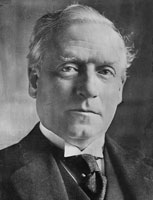 Prime Minister Henry Asquith. (1852–1928). Prime Minister from '08 to 1916. |
|
Kitchener's commanding presence awed all who came into contact with him. He despised civilians and came to work every day in his uniform.
From the very beginning of his appointment, the imperious Lord Kitchener would brook no opposition to his plans.
The success of Imperial Germany depended on the use of spies in France and Russia. Mansfield Cumming (cunning) headed the newly created MIi6 and general George Cockerill handled military "intelligence" at the War Office.
|
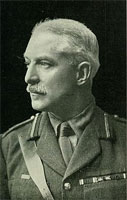 General George Cockerill (1867-1957). |
Unfortunately for Lord Kitchener, Cockerill didn't warn him in advance of the "enemy within" planning to give him a watery grave.
The youthful Winston Churchill, as 1st Lord of the Admiralty, coordinated the coming war with the Kaiser. As head of the navy, his job would entail the rapid withdrawn of the token British Expeditionary Force once France was conquered.
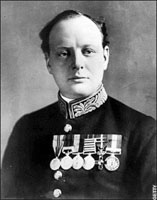 Winston Churchill (1874–1965). 1st Lord of the Admiralty from 1911 to 1915. |
|
During the first 2 weeks of the war, everything seemed to be progressing according to the plans worked out by the Kaiser, Kitchener and Churchill....Then disaster struck.
Tsar Nicholas II completely upset the Schlieffen Plan!!
When Imperial Germany invaded France in August 1914, Tsar Nicholas II ordered the mobilization of the vast Russian army. The general assigned to lead the invasion of East Prussia was a Russian patriot named Pavel (Paul) von Rennenkamph.
|
Field Marshall Helmuth von Moltke was fearful of the prospect of Russian troops entering Berlin while he occupied Paris. As a result, he lost his nerve and moved as many as 275,000 soldiers back to East Prussia. This action caused him to lose his command a few months later.
Small unforeseen events can have a major impact on history. Nobody could foresee that the Haitian Revolution, under Toussaint L'Ouverture, would change the course of history.
 Field Marshall French (1852–1925). |
|
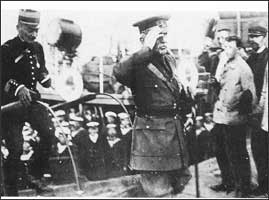 Field Marshall French landing unopposed in France in August 1914. |
French's highest ranking casualty was lieutenant general Sir James Grierson, who died of a "heart attack" and was replaced by a more compliant general.
|
By mid September, Kitchener should have contacted the Kaiser and urged him to withdraw from France and Russia. If the Kaiser did not comply, he could have ordered general Cockerill to arrange for him to have a timely death by poison.
|
The cannon fodder for the attempted invasion of Constantinople consisted mostly of Australians and New Zealanders. Kitchener knew that the Gallipoli Campaign was just a sideshow, and would take away British troops from the besieged Western Front. Since 1453, the Tsars of Russia claimed Constantinople as their city. A British conquest of that city was considered by them as worse than its occupation by the Terrible Turks.
Despite his omnipresent recruiting posters, not enough recruits were volunteering, so Kitchener ordered Prime Minister Asquith to introduce mandatory conscription.
In January 1916, the Prime Minister introduced the Military Service Act and the Bill was passed by Parliament in March of the same year.
|
Kitchener was not alive to witness the carnage of the Battle of the Somme. By 1916, he was the most hated man in the British government–not for starting the war–but for underestimating the length of the conflict.
Kitchener's failed gambit earned him a watery grave!!
His gambit that the war would only last 6 weeks was a colossal blunder. Unlike von Moltke in Germany, the powerful head of the War Office could not be forced to resign.
To make matters worse, the war was bankrupting the British Empire and they had to buy munitions from the United States. Prime Minister Asquith, Winston Churchill, and Mansfield Cumming were all unanimous that a watery grave was the best way to get rid of Kitchener.
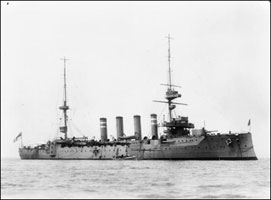 HMS Hampshire: a huge battle cruiser was assigned to take Lord Kitchener on a "secret" diplomatic mission to Russia. |
|
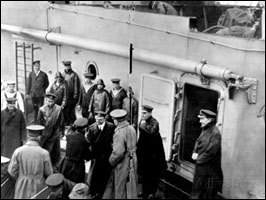 Admiral Jellicoe bidding "farewell" to Lord Kitchener on HMS Iron Duke. |
Kitchener was very, very reluctant to leave London as he knew that the government was anxious to get rid of him. As bait, King George V received a telegram from "Tsar Nicholas II" urging him to send Kitchener to Russia!!
|
|
|
Salvage work at the site has not been very successful. An attempt was made in 1933 by an Australian named "Costello," a U.S. "locksmith" named Charles Courtney, and a German named "Mansfield." The salvage team was assisted by "Merchant of Death" Sir Basil Zaharoff:
Costello also had verified the rumors about the gold. It was true that in the government archives, at least so far as a private citizen could discover, there was no record of the $10,000,000 in gold for the Russian government, but there was a record that this amount had been withdrawn from the Bank of England. Not even a wartime government draws 10,000,000 secretly and makes no record of it unless it is intended for a very important mission. (Courtney, Unlocking Adventure, p. 247).
"Locksmith" Courtney had a narrow escape from the wreck, and, predictably, he said that there were no signs of an internal explosion!!
|
|
|
Here is the wording on the plaque:
“This tower was raised by the people of Orkney in memory of Field Marshall Earl Kitchener of Khartoum on that corner of his country which he had served so faithfully nearest to the place where he died on duty. He and his staff perished along with the officers and nearly all the men of HMS Hampshire on 5th June 1916.”
Secret Service agent Winston Churchill was one of the few high ranking survivors of the deadly, disastrous war. For World War II, he adopted a modified Schlieffen Plan, with the Nazis occupying the Channel Ports. This would make great propaganda in the United States, with the "beleaguered" British Expeditionary Force saved by the "miracle" of Dunkirk.
World War II was really a replay of World War I, only Tsarist Russia was replaced by "Soviet" Russia. Kitchener's protégé, Winston Churchill, was running the war, and only the Greeks and Serbs prevented a British-Nazi victory by delaying the invasion of Russia by 6 weeks.
Vital links
References
Barton, George. Celebrated Mysteries of the Great War. The Page Company, Boston. 1919.
Cassar, George H. Kitchener's War: British Strategy from 1914 to 1916. Brassey's, Washington City, 2004.
Courtney, Charles, Unlocking Adventure. Whittlesey House, London & New York, 1942.
Meyer, G. J. A World Undone: The Story of the Great War 1914–1918. Delacorte Press, New York, 2006.
McCormick, Donald, The Mystery of Lord Kitchener's Death. Putnam, London, 1959.
McCormick, Donald, The Mask of Merlin: A Critical Biography of David Lloyd George. Holt, Rinehart and Winston, New York, 1963.
Royle, Trevor, The Kitchener Enigma. Michael Joseph, London, 1985.
Summers, Anthony. The File on the Tsar. Harper & Row, New York, 1976.
Strachan, Hew. Financing the First World War. Oxford University Press, New York, 2004.
Tuckman, Barbara. The Guns of August. Ballantine Books, New York, 1962.
Copyright © 2015 by Patrick Scrivener
